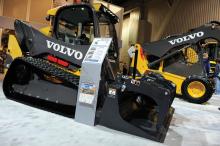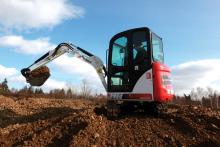The skid steer loader has for many years been known as a jack-of-all-trades. Indeed the term loader can be a bit misleading, as a skid steer is far more than simply a digging or lifting machine. Skid steers, and their more recent compact tracked loader stablemates, are the original powered tool carriers. They are designed to work with a host of attachments, not just a bucket or pallet forks. However while this concept of one base machine and a multitude of attachments has been a big success in North America

Sides skirts around this Cat planer attachment minimise dust generation
The skid steer loader has for many years been known as a jack-of-all-trades. Indeed the term loader can be a bit misleading, as a skid steer is far more than simply a digging or lifting machine
Skid steers, and their more recent compact tracked loader stablemates, are the original powered tool carriers. They are designed to work with a host of attachments, not just a bucket or pallet forks.However while this concept of one base machine and a multitude of attachments has been a big success in North America and some European markets such as Italy, others have been slow to realise the full potential of these compact powerhouses.
For the utility contractor the skid steer and compact tracked loader offer the potential for cost savings, as a company need only purchase or hire one base machine with a number of attachments, rather than four or five specific models. For example, the base carrier could be used with a hydraulic breaker, a rock wheel, a road planer, a trencher and buckets to remove old roadway. Then for reinstatement the machine can be operated with a compactor, a blade, an asphalt layer or even a sweeper collector to finish up the job.
Traditionally some of these attachments have struggled in terms of performance, as they require high flow hydraulics to function well. But manufacturers have increasingly expanded their offering, building bigger skid steers and tracked loaders and equipping them with sufficient hydraulic flow and pressure to power even the most demanding attachments.
There is no shortage of manufacturers competing in these two markets these days.
Part of Bobcat's success however has not just been in the design of its skid steers and tracked machines. The firm realised early on the potential of the multiple tool carrier, and has invested almost as much in its massive range of attachments as in the machines themselves.
The latest fruit of that development process is a range of vibratory rollers. There are five models available with widths of 1.22-2.03m. All but the largest model can be ordered with padded or smooth drums, while the 2.03m model comes with a smooth drum only. A smooth shell kit is available for the 1.22m and 1.75m padfoot models, effectively providing two attachments in one.
The rollers boast increased dynamic force, while the isolating mountings have been improved to prevent that additional vibration being transmitted into the carrier machine. Main bearings are now mounted in oil baths, removing the need for daily greasing.
Bobcat has recently announced the first of a new generation of skid steers too. The first model is the S650, which tips the scales at 3.8tonnes and has a rated operating capacity of 1.3tonnes.
Features include a 10% larger cab that is mounted further forward on the chassis and is said to offer up to 30% better visibility. Increased seat movement and suspension travel provide a smoother ride and revised control lever positioning is said to improve comfort levels.
Traction is up by 15-20%, providing greater digging power, while the standard flow hydraulic output is increased by 30% for improved attachment performance. We can expect these changes to be carried out throughout the range in coming months.
Other major players include the likes of
Cat has also added a Hystat Response Control System (HRCS) to its C Series skid steers, compact tracked and multi-terrain loaders. HRCS uses software to allow the machine's hydrostatic drive and steer system to be set at one of three response rates, standard, intermediate or maximum. This determines how quickly the machine accelerates and decelerates, and how rapidly it responds to steering commands, allowing for the experience of the operator.
The good news for existing customers is that existing machines without the advanced information and control system can be set by the dealer at one of the three response settings through the diagnostic system. The only cost is a nominal charge from the dealer for the programming work.
One of the companies that started out in skid steers and has now expanded into tracked machines is
The 1101cp will be of most interest to utility contractors, as it comes with a second auxiliary circuit providing high flow hydraulics to drive planing attachments and rock wheels.
There are however some manufacturers who have not made the move from wheels to tracks. Indeed
UK equipment distributor
"Contractors are constantly looking for innovative products to help speed up projects and reduce cost," says Westquay's sales director Garry Adey.
"These attachments allow customers to work quicker and more cost effectively." Westquay claims that the tracked loader and Simex wheel excavator, compaction wheel and asphalt paver package can increase production rates by as much as 80%. The process of cutting and excavating at the same time for instance can be a huge time saver, along with the cost of not having to back-fill large trenches dug by a machine with a bucket.
Not surprisingly, Cat has since developed its own track suspension system for its multi-terrain loaders. The ASV system though uses torsion bars and up to 16 bogie wheels per track, to ensure that the rubber track follows the contours of the ground below. Not only does this ensure excellent traction, but it also makes for a much more comfortable ride for the operator.
The Terex rubber track has no steel content at all, whereas some rubber tracks are in fact a steel track chain with rubber pads on top. Terex says that having no steel allows faster travel speeds, as there is less heat generated, and aids longer life. The company claims that a steel-embedded track can have around 600-800 hours of operating life, while its ASV tracks allow up to 1,500 hours of operation. However they may not be as well received in a demolition application, where the chance of damage to the rubber is far higher.
Perhaps the most interesting news from the skid steer market this year is the announcement of a deal between
The big benefit of this design is that the machines have a conventional side-mounted door, rather than the operator having to climb into the cab over the attachments, which greatly increases safety. Despite some criticism from competitors, the JCB design has proven robust, and we have yet to hear of a boom breaking.
Volvo purchased a US skid steer manufacturer some years ago but has never marketed the machines outside the American market. Now the firm has signed a framework agreement with JCB to cooperate on engineering and manufacturing of skid steers and compact tracked loaders.
The first single-armed Volvo-branded machines are expected to roll out of JCB's North American plant in Savannah, Georgia by the end of this year. There is no further information at present, but the intention is that both companies will sell the machines under their own brands, through their individual global dealer networks.
For JCB the deal will open up new markets for the machines in which Volvo is strong, while for Volvo the agreement provides access to a much larger range of skid steers and tracked loaders, with the proven performance and safety that it requires.
While skid steers and compact tracked loaders are undeniably compact machines, they can offer big machine performance for a utility contractor, with dedicated attachments designed to work with the oil flow and pressures available. By choosing the right mix of machine and attachments, a contractor can reduce the number of machines needed to carry out a job, and increase the speed with which that task can be carried out.
The secondary benefit of using a single tool carrier with a range of attachments is that utilisation, the holy grail for rental companies, should remain high for the main machine. Choose wisely among the vast array of attachments on offer, and that jack-of-all-trades can become the master of many.








